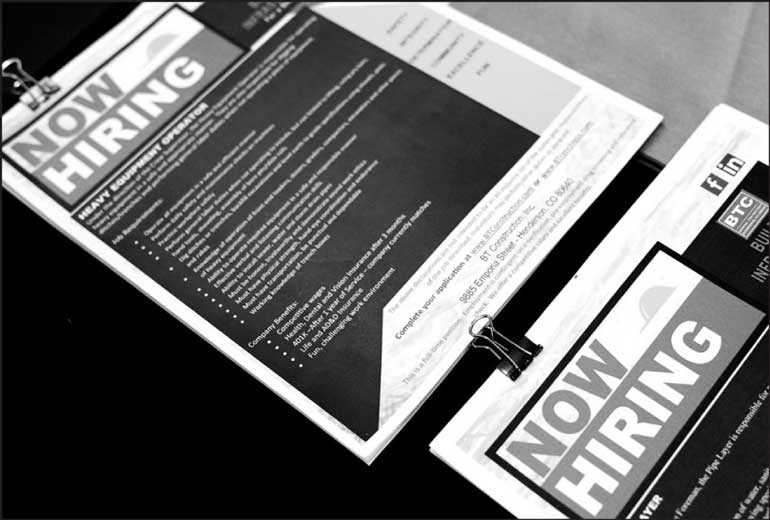Sunday Mar 16, 2025
Sunday Mar 16, 2025
Saturday, 8 June 2019 00:02 - - {{hitsCtrl.values.hits}}

Brochures are displayed for job seekers at the ‘Construction Careers Now!’ hiring event in Denver, Colorado US 2 August 2017 – Reuters
WASHINGTON (Reuters): US job growth likely increased solidly in May, with wage gains expected to pick up, showing strength in the labour market before an escalation in trade tensions that analysts have cautioned could pressure an already slowing economy.
With the trade war drums beating loudly in the background, a strong employment report from the Labor Department on Friday will probably do little to dial back market expectations that the Federal Reserve will cut interest rates this year. Fed Chairman Jerome Powell said on Tuesday the central bank was closely monitoring the implications of the trade tensions on the economy and would “act as appropriate to sustain the expansion.”
President Donald Trump in early May slapped additional tariffs of up to 25% on $200 billion of Chinese goods, which prompted retaliation by Beijing. Last week, Trump said he would impose a tariff on all goods from Mexico in a bid to stem the tide of migrants across the US-Mexican border.
Talks are ongoing to prevent the duties from kicking in at 5% on 10 June.
Nonfarm payrolls probably increased by 185,000 jobs last month after surging 263,000 in April, according to a Reuters survey of economists. That would be well above the roughly 100,000 needed per month to keep up with growth in the working-age population.
“The trade wars the United States finds itself ensnared in are going to cause hiring to slow as business sentiment eases, productivity-enhancing capital expenditures fall off, and the damage eventually spills over into the consumer sector,” said Joseph Brusuelas, Chief Economist at RSM US in New York.
Manufacturing payrolls will be watched closely for signs of the impact of the tariffs on the economy. Factory output has been weak and sentiment dropped to a 31-month low in May, with manufacturers worried mostly about the trade tensions.
But May’s job growth could disappoint after a report on Wednesday from payrolls processing firm ADP showed the smallest gain in private payrolls in nine years last month. Another report this week showed a drop in online adverts by businesses looking for help.
The ADP report, however, has a poor record predicting the private payrolls component of the government’s employment report because of methodology differences. Other labor market measures such as weekly applications for unemployment benefits and the Institute for Supply Management’s services employment gauge have suggested solid employment gains in May.
Some wage inflation
Monthly wage growth is expected to have pushed higher in May, with average hourly earnings forecast increasing 0.3% after rising 0.2% in April. Wages were forecast advancing 3.2% in the 12 months to May. The workers are also likely put in more hours last month.
While the steady wage growth would support the Fed’s optimism that inflation would return to the US central bank’s 2% target, economists said that was likely to take a backstage to the uncertainty wrought by the trade tensions.
“With the ongoing trade dispute front and centre, worries that worsening household and business confidence will lead to people closing their pocketbooks may give the Fed one more reason to do a pre-emptive rate cut,” said Beth Ann Bovino, US Chief Economist for S&P Global Ratings.
Financial markets are pricing in two rate cuts this year. Despite slower job growth as workers become more scarce, labour market strength is likely to support the economy. Growth is cooling as the massive stimulus from last year’s tax cuts and spending increases fades.
The Atlanta Fed is forecasting gross domestic product rising at a 1.5% annualised rate in the second quarter. The economy grew at a 3.1% pace in the first quarter.
The unemployment rate is expected to have remained near a 50-year low of 3.6% in May. The jobless rate was partly pushed down by workers dropping out of the labour force over the last four months. A rebound is expected in the labour force participation rate, or the proportion of working-age Americans who have a job or are looking for one.
Employment gains in May were likely across all sectors, though the pace probably slowed from April.
Manufacturing payrolls are forecast to have increased by 5,000 last month, but the auto industry probably shed more jobs as assembly plants cut production of some models to address declining sales and an inventory bloat.
Another month of job gains is expected in the construction sector after employers hired 33,000 workers in April. Government payrolls are forecast increasing by at least 10,000 jobs in May, but hiring for the 2020 Census is a wild card to the estimate.
Discover Kapruka, the leading online shopping platform in Sri Lanka, where you can conveniently send Gifts and Flowers to your loved ones for any event including Valentine ’s Day. Explore a wide range of popular Shopping Categories on Kapruka, including Toys, Groceries, Electronics, Birthday Cakes, Fruits, Chocolates, Flower Bouquets, Clothing, Watches, Lingerie, Gift Sets and Jewellery. Also if you’re interested in selling with Kapruka, Partner Central by Kapruka is the best solution to start with. Moreover, through Kapruka Global Shop, you can also enjoy the convenience of purchasing products from renowned platforms like Amazon and eBay and have them delivered to Sri Lanka.
Discover Kapruka, the leading online shopping platform in Sri Lanka, where you can conveniently send Gifts and Flowers to your loved ones for any event including Valentine ’s Day. Explore a wide range of popular Shopping Categories on Kapruka, including Toys, Groceries, Electronics, Birthday Cakes, Fruits, Chocolates, Flower Bouquets, Clothing, Watches, Lingerie, Gift Sets and Jewellery. Also if you’re interested in selling with Kapruka, Partner Central by Kapruka is the best solution to start with. Moreover, through Kapruka Global Shop, you can also enjoy the convenience of purchasing products from renowned platforms like Amazon and eBay and have them delivered to Sri Lanka.